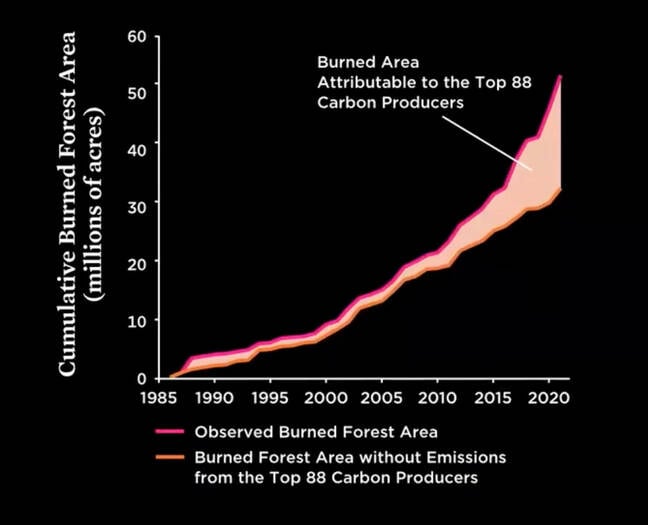Comment You surely noticed much of the world was on fire this year, especially if you were in the western United States, western or eastern Canada, Australia, Greece, Italy, Spain, Portugal, Algeria, Tunisia… you get the idea.
At the annual conference of the American Geophysical Union, held this year in San Francisco, Kristina Dahl of the Union of Concerned Scientists (UCS) expressed, well, concern about about what — and who — might be held responsible for the recent rise in wild, wild wildfires. To find out, she and her team indulged themselves in what scientists most enjoy: research.
“This research really focused on one key question,” she told an assembly of AGU scientists, “which was, ‘How much of the increase in wildfire activity in western North America is attributable to emissions from the world’s largest fossil fuel producers and cement manufacturers?'”
Her team’s research began how all good research begins: with data. Although best estimates show a total of 1,499 gigatons of global-warming–exacerbating CO2 have been added to the Earth’s atmosphere by the actions of us humans since 1751, only 342 gigatons of those were emitted up to 1964 — 23 percent of the total emissions during those 213 years, which was 80 percent per cent of that full time frame. On the other hand, 1,157 gigatons were emitted between 1965 and 2015 — that’s 77 percent of total emissions emitted during only the remaining 20 percent of the period in question.
That extreme rise in CO2 emissions is not a surprise. There are more and more of us on this planet, and globally we’re driving more, flying more, using electricity more, heating our homes more, and generally living more carbon-intensive lives than ever before. We’re building more things out of cement. However, what is perhaps surprising — and concerning to this particular union of scientists – is as Dahl put it: “That 77 percent of this these emissions have taken place since fossil fuel companies became aware of what the dangers of burning their products would be.”
As anyone who follows such matters knows, evidence has surfaced demonstrating that for at least the past half-century fossil fuel companies have been aware of those dangers. However, as Dahl put it, “Instead of using that knowledge to change their business practices, or to alert the public or policymakers about what the dangers of burning fossil fuels would be, they’ve doubled down on their business models. They have funded climate obstruction on every level from global to local.”
The alternative to stopping climate change is untested carbon capture tech
Climate change prevention plans ‘way off track’, says UN
Fusion won’t avert need for climate change ‘sacrifice’, says nuclear energy expert
Bill Gates on climate change: Planting trees is not the answer, emissions need to be zeroed out to avoid disaster
The clear question, then, is what responsibility do these companies have regarding their contributions to the climate impacts we’re experiencing: the extreme weather events, rising sea levels, ocean acidification, and the like?
Some communities around the globe are seeking to answer that question in the courts, and are suing fossil-fuel companies for damages. Those lawsuits need a few questions to be answered to proceed, not the least of which being the classic, “What did they know and when did they know it?” Also, any negative effects from fossil-fuel companies’ alleged reticence to come clean about their own research and findings regarding CO2 emissions will have to be quantified and presented in a way that satisfies the courts.
Climate-event attribution science has come a long way in recent years, not only in attributing climate change in general to industrial contributions, but more importantly — and more specifically — in attributing the amplification of classes or specific instances of extreme weather events to anthropogenic climate-change contributions, and even to the contributions of specific industries.
And that’s where the work of Dr Dahl and her team kicks in: a discipline she identified as Source Attribution Science.
She and her colleagues tasked themselves with looking into the CO2-emission contributions of 88 industrial players, including such biggies as ExxonMobil, Shell, Chevron, and BP, and related their contributions to studies linking fossil fuels and cement manufacturing to such matters as heat waves, sea-level rise, and ocean acidification.
One study that Dahl cited, published in the journal Climate Change in 2017, concluded that between 42 and 50 percent of global temperature rise, and between 26 and 32 percent of global sea level rise, could be clearly traced to such companies as those that Dahl’s team investigated.
Dr Dahl and her compatriots then asked themselves whether it might be possible to do the same type of source attribution to the recent spate of increased wildfire activity in the western United States and southwestern Canada during the past few decades. “They’re burning much larger areas; they’re burning more severely; they’re burning at much higher elevations, and they’re burning year-round,” she said.
The increase in wildfire severity has a number of different causes, to be fair, not the least of which being fire suppression and the intrusion of civilization into formerly wild areas. The question that Dahl et al were interested in, however, was to tease out the climate component in that increase, and then determine their “top 88” industry players’ contribution to that component.
To accomplish that goal, the scientists first looked at the rising vapor pressure deficit (VPD) — a measure of how much the atmosphere can suck moisture out of plants — in the area of interest. The higher the temperature, the drier the air, the higher the VPD, and therefore the drier the vegetation. A high VPD indicates a higher inevitability of severe and widespread wildfires and a longer wildfire season. And, yup, VPD was rising in the timeframe and the area under examination.
Dahl’s team then had the two sources they needed to move further in their study: that the Top 88 contributed to global temperature increase, and that global temperature increases VPD, which increases the spread of wildfires. Their goal was then to see if they could empirically connect CO2 emissions to the rise in VPD in the selected area, and therefore quantify those emissions’ contribution to wildfires.
To do this they employed the standard and well-accepted CMIP6 climate model, running it both with and without emissions as contributed by the 88 companies in question, tasking the model to provide results from 1901 through 2020. CMIP6’s results showed an increase in VPD of around 42 percent during that period due to contributions by the corporations in question, with the most severe change beginning in the mid-1980s.

Graph from Dr Dahl’s presentation suggesting emissions from top carbon producers are responsible for tens of millions of acres of forest fires
As you can see above, the team took that data and plotted it against the total forest area burned between 1986 and 2020, and discovered that, in Dahl’s words, “Overall we found that about 37 per cent of the area that has burned since the mid-1980s in this part of the world is attributable to the emissions from these companies.”
As might be obvious, this level of data-informed and analysis-supported attribution of industry contributions to quantifiable loss and damage is useful in ongoing and future litigation — so much so that Dahl’s organization, the Union of Concerned Scientists, has a program specifically oriented to connecting scientists with legal scholars and lawyers “working at the intersection of science and climate litigation.” It’s called the UCS Science Hub for Climate Litigation. Interested? Check it out right here. ®
>>> Read full article>>>
Copyright for syndicated content belongs to the linked Source : The Register – https://go.theregister.com/feed/www.theregister.com/2023/12/16/fossil_fuels_wildfires/
































Trump Boasts About Reviving America’s Economy – But Overlooks the True Challenge